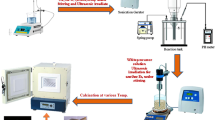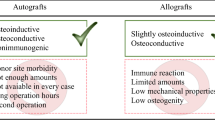Abstract
The objective of this study was to improve the efficacy of polycaprolactone/bioglass (PCL/BG) bone substitute using demineralized bone matrix (DBM) or calcium sulfate (CS) as a third component. Composite discs involving either DBM or CS were prepared by compression moulding. Bioactivity of discs was evaluated by energy dispersive X-ray spectroscopy (ESCA) and scanning electron microscopy (SEM) following simulated body fluid incubation. The closest Calcium/Phosphate ratio to that of hydroxyl carbonate apatite crystals was observed for PCL/BG/DBM group (1.53) after 15 day incubation. Addition of fillers increased microhardness and compressive modulus of discs. However, after 4 and 6-week PBS incubations, PCL/BG/DBM discs showed significant decrease in modulus (from 266.23 to 54.04 and 33.45 MPa, respectively) in parallel with its highest water uptakes (36.3 and 34.7%). Discs preserved their integrity with only considerable weight loss (7.5–14.5%) in PCL/BG/DBM group. In vitro cytotoxicity tests showed that all discs were biocompatible. Composites were implanted to defects on rabbit humeri. After 7 weeks, new tissue formation and mineralization at bone-implant interface were observed for all implants. Bone mineral densities at interface were higher than that of implant site and negative controls (defects left empty) but lower than healthy bone level. However, microhardness of implant sites was higher than in vitro results indicating in vivo mineralization of implants. Addition of DBM or CS resulted with higher microhardness values at interface region (ca. 650 μm from implant) compared to PCL/BG and negative control. Histological studies revealed that addition of DBM enhanced bone formation around and into implant while CS provided cartilage tissue formation around the implant. From these results, addition of DBM or CS could be suggested to improve bone healing efficacy of PCL/BG composites.












Similar content being viewed by others
References
Coetzee AS. Regeneration of bone in the presence of calcium sulfate. Arch Otolaryngol. 1980;106:405–9.
Stubbs D, Deakin M, Chapman-Sheath P, Bruce W, Debes J, Gillies RM, et al. In vivo evaluation of resorbable bone graft substitutes in a rabbit tibial defect model. Biomaterials. 2004;25(20):5037–44.
Abjornson C, Lane JM. Demineralized bone matrix and synthetic bone graft substitutes. In: Friedlaender GE, Mankin HJ, Goldberg VM, editors. Bone grafts and bone graft substitutes. Rosemont: American Academy of Orthopaedic Surgeons; 2006. p. 9–20.
Cook SD, Salkeld SL, Patron LP, Barrack RL. The effect of demineralized bone matrix gel on bone ingrowth and fixation of porous implants. J Arthroplasty. 2002;17:402–8.
Calandrelli L, Immirzi B, Malinconico M, Volpe MG, Oliva A, Della Ragione F. Preparation and characterisation of composites based on biodegradable polymers for in vivo application. Polymer. 2000;41:8027–33.
Lu HH, Tang A, Oh SC, Spalazzi JP, Dionisio K. Compositional effects on the formation of a calcium phosphate layer and the response of osteoblast-like cells on polymer-bioactive glass composites. Biomaterials. 2005;26:6323–34.
Chouzouri G, Xanthos M. In vitro bioactivity and degradation of polycaprolactone composites containing silicate fillers. Acta Biomater. 2007;3:745–56.
Prabhakar RL, Brocchini S, Knowles JC. Effect of glass composition on the degradation properties and ion release characteristics of phosphate glass-polycaprolactone composites. Biomaterials. 2005;26:2209–18.
Hao J, Yuan M, Deng X. Biodegradable and biocompatible nanocomposites of poly(ε-caprolactone) with hydroxyapatite nanocrystals: thermal and mechanical properties. J Appl Polym Sci. 2002;86:676–83.
Kim BK, Hwang SJ, Park JB, Park HJ. Characteristics of felodipine-located poly(-caprolactone) microspheres. J Microencapsulation. 2005;22:193–203.
Rai B, Teoh SH, Ho KH. The effect of rhBMP-2 on canine osteoblasts seeded onto 3D bioactive polycaprolactone scaffolds. Biomaterials. 2004;25:5499–506.
Pitt C. Poly(ε-caprolactone) and its copolymers. In: Chasin M, Langer R, editors. Biodegradable polymers as drug delivery systems. New York: Marcel-dekker; 1990. p. 71–120.
Coombes AGA, Rizzi SC, Williamson M, Barralet JE, Downes S, Wallace WA. Precipitation casting of polycaprolactone for applications in tissue engineering and drug delivery. Biomaterials. 2004;25:315–25.
Mano JF, Sousa RA, Boesel LF, Neves NM, Reis RL. Bioinert, biodegradable and injectable polymeric matrix composites for hard tissue replacement: state of the art and recent developments. Compos Sci Technol. 2004;64:789–817.
Azevedo MC, Reis RL, Claase MB, Grijpma DW, Feijen J. Development and properties of polycaprolactone/hydroxyapatite composite biomaterials. J Mater Sci: Mater Med. 2003;14:103–7.
Jukola H, Nikkola L, Gomes ME, Chiellini F, Tukiainen M, Kellomäki M, et al. Development of a bioactive glass fiber reinforced starch–polycaprolactone composite. J Biomed Mater Res Part B: Appl Biomater. 2008;87:197–203.
Jiang G, Evans ME, Jones IA, Rudd CD, Scotchford CA, Walker GS. Preparation of poly(e-caprolactone)/continuous bioglass fibre composite using monomer transfer moulding for bone implant. Biomaterials. 2005;26:2281–8.
Lei Y, Rai B, Ho KH, Teoh SH. In vitro degradation of novel bioactive polycaprolactone—20% tricalcium phosphate composite scaffolds for bone engineering. Mater Sci Eng C. 2007;27:293–8.
Yuan H, de Bruijn JD, Zhang X, van Blitterswijk CA, de Groot K. Bone induction by porous glass ceramic made from bioglass (45S5). J Biomed Mater Res (Appl Biomater). 2001;58:270–6.
Chan C, Thompson I, Robinson P, Wilson J, Hench L. Evaluation of bioglass/dextran composite as a bone graft substitute. Int J Oral and Maxillofac Surg. 2002;31:73–7.
Oliva A, Salerno A, Locardi B, Riccio V, Della Ragione F, Iardino P, et al. Behaviour of human osteoblasts cultured on bioactive glass coatings. Biomaterials. 1998;19:1019–25.
Shapoff CA, Alexander DC, Clark AE. Clinical use of a bioactive glass particulate in the treatment of human osseous defects. Compend Contin Educ Dent. 1997;18:356–63.
Müller L, Müller FA. Preparation of SBF with different HCO3 − content and its influence on the composition of biomimetic apatites. Acta Biomater. 2006;2:181–9.
Fini M, Giavaresi G, Aldini NN, Torricelli P, Botter R, Beruto D, et al. A bone substitute composed of polymethylmethacrylate and a-tricalcium phosphate: results in terms of osteoblast function and bone tissue formation. Biomaterials. 2002;23:4523–31.
Furumatsu T, Shen ZN, Kawai A, Nishida K, Manabe H, Oohashi T, et al. Vascular endothelial growth factor principally acts as the main angiogenic factor in the early stage of human osteoblastogenesis. J Biochem. 2003;133:633–9.
Shao XX, Hutmacher DW, Ho ST, Goh JCH, Lee EH. Evaluation of a hybrid scaffold/cell construct in repair of high-load-bearing osteochondral defects in rabbits. Biomaterials. 2006;27:1071–80.
Gu YW, Tay BY, Lim CS, Yong MS. Biomimetic deposition of apatite coating on surface-modified NiTi alloy. Biomaterials. 2005;26:6916–23.
Feng B, Chen JY, Qi SK, He L, Zhao JZ, Zhang XD. Characterization of surface oxide films on titanium and bioactivity. J Mater Sci: Mater Med. 2002;13:457–64.
Kokubo T, Kim HM, Kawashita M. Novel bioactive materials with different mechanical properties. Biomaterials. 2003;24:2161–75.
Maeda H, Maquet V, Chen QZ, Kasuga T, Jawad H, Boccaccini AR. Bioactive coatings by vaterite deposition on polymer substrates of different composition and morphology. Mater Sci Eng C. 2007;27:741–5.
Xin R, Leng Y, Chen J, Zhang Q. A comparative study of calcium phosphate formation on bioceramics in vitro and in vivo. Biomaterials. 2005;26:6477–86.
Han B, Yang Z, Nimni M. Effects of moisture and temperature on the osteoinductivity of demineralized bone matrix. J Orthop Res. 2005;23:855–61.
Sun H, Mei L, Song C, Cui X, Wang P. The in vivo degradation, absorption and excretion of PCL-based implant. Biomaterials. 2006;27:1735–40.
Yeo A, Rai B, Sju E, Cheong JJ, Teoh SH. The degradation profile of novel, bioresorbable PCL-TCP scaffolds: an in vitro and in vivo study. J Biomed Mater Res. 2008;84A:208–18.
Clark PA, Moioli EK, Sumner DR, Mao JJ. Porous implants as drug delivery vehicles to augment host tissue integration. FASEB J. 2008;22:1684–93.
Doblaré M, García JM, Gómez MJ. Modelling bone tissue fracture and healing: a review. Eng Fract Mech. 2004;71:1809–40.
Aldini NN, Fini M, Giavaresi G, Torricelli P, Martini L, Giardino R, et al. Improvement in zirconia osseointegration by means of a biological glass coating: an in vitro and in vivo investigation. J Biomed Mater Res. 2002;61A:282–9.
Lowry KJ, Hamson KR, Bear L, Peng YB, Calaluce R, Evans ML, et al. Polycaprolactone/glass bioabsorbable implant in a rabbit humerus fracture model. J Biomed Mater Res. 1997;36:536–41.
Savarino L, Baldini N, Greco M, Capitani O, Pinna S, Valentini S, et al. The performance of poly-e-caprolactone scaffolds in a rabbit femur model with and without autologous stromal cells and BMP4. Biomaterials. 2007;28:3101–9.
Oh SH, Park IK, Kim JM, Lee JH. In vitro and in vivo characteristics of PCL scaffolds with pore size gradient fabricated by a centrifugation method. Biomaterials. 2007;28:1664–71.
Lam CXF, Hutmacher DW, Schantz JT, Woodruff MA, Teoh SH. Evaluation of polycaprolactone scaffold degradation for 6 months in vitro and in vivo. J Biomed Mater Res. 2009;90A:906–19.
Woodward SC, Brewer PS, Moatamed F, Schindler A, Pitt CG. The intracellular degradation of poly (epsilon-caprolactone). J Biomed Mater Res. 1985;19:437–44.
Moimas L, Biasotto M, di Lenarda R, Olivo A, Schmid C. Rabbit pilot study on the resorbability of three-dimensional bioactive glass fibre scaffolds. Acta Biomater. 2006;2:191–9.
Hing KA, Wilson LF, Buckland T. Comparative performance of three ceramic bone graft substitutes. The Spine J. 2007;7:475–90.
Al Ruhaimi KA. Effect of calcium sulphate on the rate of osteogenesis in distracted bone. Int J Oral Maxillofac Surg. 2001;30:228–33.
Acknowledgements
This study was supported by the Scientific and Technological Research Council of Turkey, TUBITAK (Project no: 104M172).
Author information
Authors and Affiliations
Corresponding author
Rights and permissions
About this article
Cite this article
Erdemli, O., Çaptug, O., Bilgili, H. et al. In vitro and in vivo evaluation of the effects of demineralized bone matrix or calcium sulfate addition to polycaprolactone–bioglass composites. J Mater Sci: Mater Med 21, 295–308 (2010). https://doi.org/10.1007/s10856-009-3862-6
Received:
Accepted:
Published:
Issue Date:
DOI: https://doi.org/10.1007/s10856-009-3862-6




